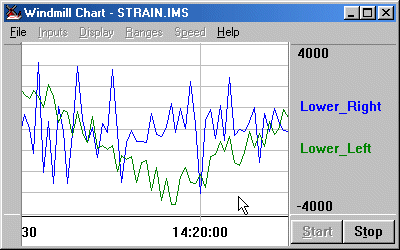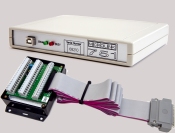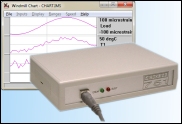Windmill's 751-SG package has lets you monitor 16 strain gauges, balanced bridges like pressure transducers and voltage signals. This USB unit also provides 32 digital inputs and outputs and 8 counters. Connect eight units to one PC and monitor 128 strain gauges.
Features
- Monitor strain gauges, or voltage signals, through 16 differential input channels
- Switch up to 32 digital outputs
- Monitor up to 32 digital inputs
- Count events with up to 8 counters
- Options to also monitor temperature, pressure and current
- Includes the powerful yet easy-to-use Windmill Software for Windows: no programming required
- Connect up to 8 units to one PC, giving 128 strain or voltage inputs and 256 digital inputs and outputs
- Powered from the PC
- Low power consumption
- Connects over USB
- Choice of four analogue input ranges, selected with Windmill software individually for each channel
- Alternatively, choose automatic ranging and let the software match the input signal as closely as possible
- Integrating analogue-to-digital converter reduces electrical noise
- Use Windmill to select the resolution of the A-D converter from 12- to 18-bits: choose high throughput or high resolution
- Automatic recalibration
- Comprehensive User Manual
- Free technical support for life and money-back guarantee if not satisfied
Strain Measurement
The Windmill 751-SG package lets you monitor strain gauge bridges and balanced bridges such as pressure transducers. You can configure individual channels to accept any of these inputs:
- voltage
- quarter bridge: single strain gauge
- half bridge: tensile + compressive strain gauge
- half bridge: normal + transverse strain gauge
- full bridge: 2 tensile + 2 compressive gauges
- full bridge: 2 normal + 2 transverse gauges
- full bridge: tensile normal + compressive normal + tensile transverse + compressive transverse gauge
Strain gauges need an external excitation voltage to supply sufficient current to keep all the bridge circuits energised. The 751-SG package provides four sets of 16 screw terminals giving + and - excitation and signals for each of 16 bridges. Two 1 kOhm termination resistors are mounted in half bridge configuration whilst high quality 350 and 120 Ohm resistors can be provided for the completion of quarter bridges.
When a bridge input is selected the Windmill software monitors excitation voltage and performs the bridge calculation to produce a reading in microstrain. This eliminates errors due to changes in excitation voltage.
The initial unstrained bridge measurement is often much larger than the change in signal due to strain. If this initial value is not accounted for, it restricts the resolution you can obtain - i.e. the smallest signal you can measure. Windmill software can zero or balance the bridge, nulling the offset of the initial voltage. So instead of measuring over a wide range, 0 to 0.5 V for example, you can choose a narrow range such as 0 to 0.01 V.
Each range is divided into a fixed number of steps: the resolution. The smaller the range and the larger the resolution, the more precise the reading. The 751-SG offers a choice of resolutions from 12-bit for fast sampling to 18-bit for greater precision.
If you would like more information on strain measurement techniques, there is an article on our Data Acquisition Intelligence site.
Digital Inputs and Outputs
The 751-SG provides 32 digital I/O lines, arranged in four groups of 8. Use Windmill to choose whether each group is an input or an output. You can read or set the state of each line individually. Alternatively, you can switch several channels at the same time.
Counters
The USB unit has eight 16-bit totalling counters. Each counter starts at zero and counts pulses to a maximum of 65535. You can reset a counter at any time from Windmill software. You can use the counters in two modes: accumulating count and resetting count. In accumulating count the counter keeps counting until you reset it. In resetting count the counter shows the number of pulses since the last reading.
You can set a scale and offset factor to the count from software. For example if the pulses came from a flow meter which produced one pulse for every 50 millilitres, a scale factor of 0.05 would give a reading in litres.
The counters are found on 8 of the digital input and output lines. You can use any of these you don't need for counting as normal digital inputs: the counts are always maintained even if you don't plan to use them.
Software
Windmill Software is included in the 751-SG package. This modular suite offers data logging, charting, alarm indication, output control and real-time links to other applications like Excel. You can also add process mimic generators, sequence control and many other modules. Should you wish to program the hardware yourself, you can use the IML Tools to do so.

Windmill Chart software
Windmill 751-SG Unit Specifications
Dimensions (mm) 180 x 120 x 40
Maximum length of cable 5 m
Maximum distance from PC can be increased by
use of USB hubs
ANALOGUE INPUTS
Maximum safe input voltage:
Power supply on ±48 V
Power supply off ±33 V
Transient ±300 V
Amplifier:
Ranges (V) ±0.01, ±0.1, ±1, ±10
Common mode range ±13 V
Relative accuracy of ranges:
gain = 1000 ±0.1%
gain = 1, 10, 100 ±0.05%
Analogue to Digital Converter:
Maximum linearity error ±0.02%
Resolution Integration Time Samples/Second
12 bits 2.5 msec 80
13 bits 5 msec 64
14 bits 10 msec 48
15 bits 20 msec 32
16 bits 40 msec 16
18 bits 160 msec 6
DIGITAL INPUTS/OUTPUTS
Maximum # inputs 32
Maximum # outputs 32
(selected through Windmill in ports of 8 lines)
Power-up state all inputs
Compatibility TTL and 5 V CMOS, can be made
contact closure compatible
Range 0 to 5 V
Output capability 15 LSTLL loads
Maximum I/O speed 160 channels per second
COUNTERS
Resolution 16 bits
Compatibility TTL, 5 V CMOS, can be made
contact closure compatible
Input voltage range 0 to 5 V
Maximum count speed 160 counts per second
Download the 751-SG User Manual...





